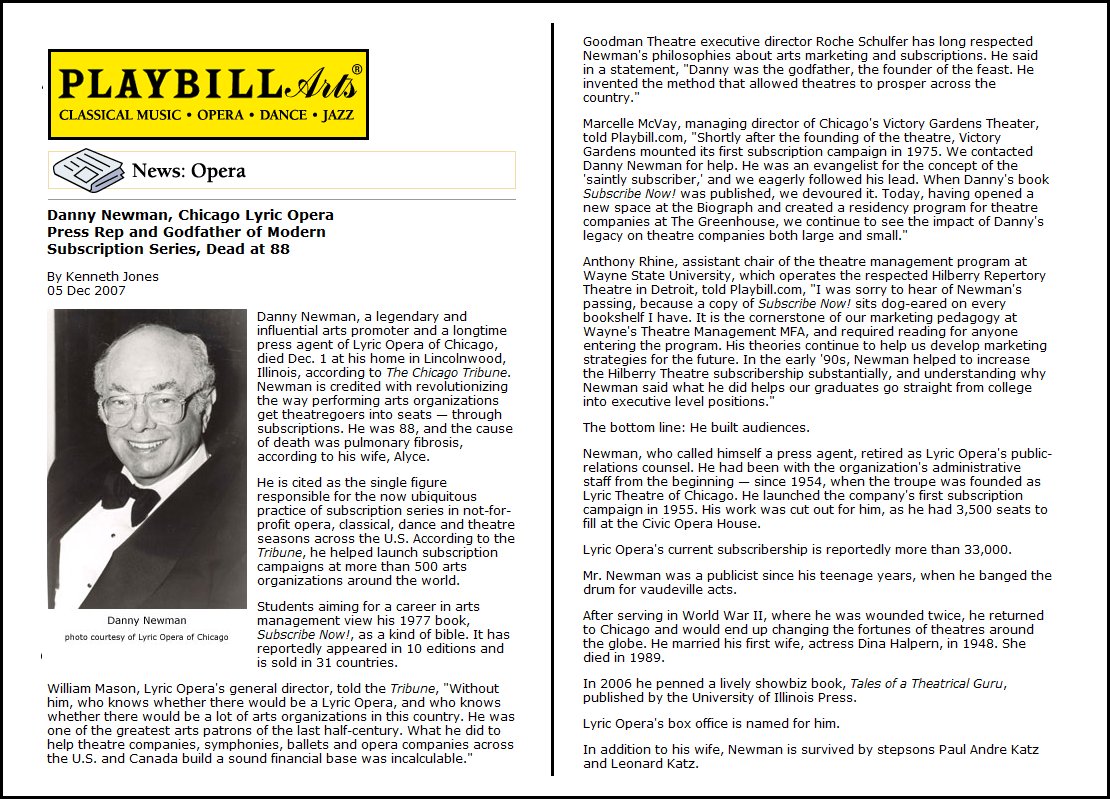

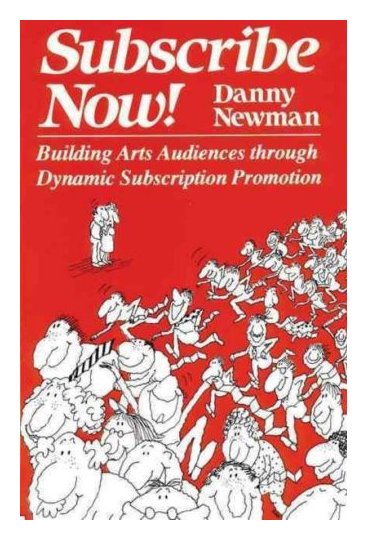 While promoting his book, Subscribe Now!, he wrote a brief
synopsis of his path in life which he delivered as he started off his
personal appearances. I asked him to read that onto the tape,
which he did with appropriate gusto . . . . .
While promoting his book, Subscribe Now!, he wrote a brief
synopsis of his path in life which he delivered as he started off his
personal appearances. I asked him to read that onto the tape,
which he did with appropriate gusto . . . . .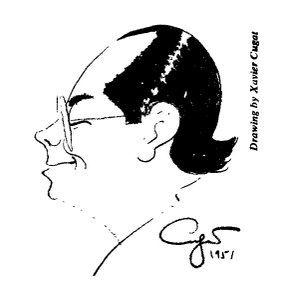 BD: But you enjoy
hearing the tune?
BD: But you enjoy
hearing the tune?| W. McNeil Lowry Is Dead; Patron
of the Arts Was 80 By JACK ANDERSON Published: June 7, 1993, The New York Times [Text only. Photo from another source.] W. McNeil Lowry, a former vice president of the Ford Foundation who made that institution a major supporter of the arts, died yesterday at his home in Manhattan. He was 80. The cause was cancer of the esophagus, said his wife, Elsa. Through his efforts, Mr. Lowry (whose full name was Wilson McNeil Lowry) helped make the Ford Foundation America's largest nongovernmental arts patron and the first foundation to support dance. The effects of his cultural campaigning were so great that Lincoln Kirstein, a co-founder of the New York City Ballet, called him "the single most influential patron of the performing arts that the American democratic system has produced." 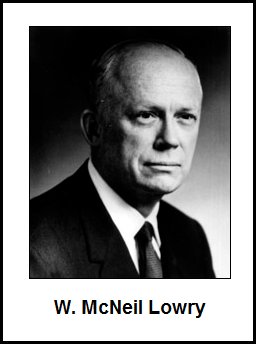 Mr.
Lowry joined the Ford Foundation in 1953 to head its education program.
He became the director of its arts and humanities programs in 1957 and
vice president in 1964. After retiring from the foundation in 1974, he
was in demand as an arts consultant, and from 1988 to 1991 he was
president of the board of the San Francisco Ballet. Although Mr. Lowry,
who was familiarly known as Mac, could seem mildly professorial in
manner, he proved to be tough-minded and strong-willed. Modest Grants,
Then Expansion Mr.
Lowry joined the Ford Foundation in 1953 to head its education program.
He became the director of its arts and humanities programs in 1957 and
vice president in 1964. After retiring from the foundation in 1974, he
was in demand as an arts consultant, and from 1988 to 1991 he was
president of the board of the San Francisco Ballet. Although Mr. Lowry,
who was familiarly known as Mac, could seem mildly professorial in
manner, he proved to be tough-minded and strong-willed. Modest Grants,
Then ExpansionUnder his guidance, the Ford Foundation began to support the arts in a modest way. Yet many of its early grants were important. A grant of $105,000 in 1957 enabled the New York City Opera to present a season of American operas, and another of $210,000 that same year to symphony orchestras across the country went toward the commissioning of 18 new symphonic compositions. The foundation expanded its arts program in 1962 with grants totaling $6.1 million to nine nonprofit repertory theaters. Later grants went to writers, film makers, art schools and conservatories of music. In 1967 a Ford grant helped establish the Negro Ensemble Company. In 1963, believing that dance was an underfinanced art, Mr. Lowry spearheaded a project through which more than $7.7 million was shared by eight ballet organizations: the New York City Ballet, its affiliated School of American Ballet, the National Ballet in Washington, the San Francisco Ballet, the Pennsylvania Ballet, the Utah Ballet (now Ballet West), the Houston Ballet and the Boston Ballet. No foundation had ever supported dance on such a scale. Yet far from inspiring elation, the grants were greeted in some quarters with dismay. Supporters of modern dance complained that their idiom had been ignored. From within ballet itself came a second charge: that the leaders of the regional ballet groups had been connected at some point with either the City Ballet or with its principal choreographer, George Balanchine, when he was associated with other troupes. Although debates raged over the foundation's choices, Mr. Lowry's subsequent policy decisions helped make up for any lapses of 1963. Modern dance eventually received Ford Foundation support; so did companies including American Ballet Theater and the Joffrey Ballet. Moreover, the precedent of the Ford grants inspired corporations and other foundations to aid dance in their own way. Roots in the Midwest Mr. Lowry took criticisms seriously, if philosophically. Typically, in 1973, he said: "There is no way to be in this post without getting both plaudits and criticism, sometimes intemperate and inaccurate. I don't mind being put under the villains. I can look at myself in the mirror and see a villain." No matter what the artistic field, Mr. Lowry encouraged activities across the nation. He explained why in a 1962 interview in The New York Times: "I suppose the fact that I was born 80 miles from the exact geographical center of the United States has given the foundation's program a grass-roots approach." The place to which he referred was Columbus, Kan., where Mr. Lowry was born on Feb. 17, 1913. He received his bachelor's degree in 1934 and his Ph.D. in 1941 from the University of Illinois, where he taught English from 1936 to 1942. In 1936 he married Elsa Alberta Koch. During World War II, Mr. Lowry served on active duty as a lieutenant in the United States Naval Reserve and as a writer for the Office of War Information. He then embarked on a journalistic career. He was editor of The Dayton (Ohio) Daily News in 1946 and 1947; chief of the Washington bureau of the Cox Newspapers from 1947 to 1952, and associate director of the International Press Institute in Zurich in 1952 and 1953. Before his wartime service, Mr. Lowry edited Accent, a literary journal, from 1940 to 1942, and over the years he contributed to publications including The New York Times Book Review, The Reporter, The Progressive, Antioch Review and Educational Theater Journal, among others. Encouraging Collaboration After leaving the Ford Foundation, Mr. Lowry helped organize conferences for the American Assembly, which had been established at Columbia University in 1950 as a public-affairs forum. He edited "The Performing Arts and American Society," a background volume for the American Assembly of 1978, and wrote "The Arts and Public Policy in the United States" under the assembly's auspices in 1981. In 1975 he directed a study of the arts in America for the American Council of Learned Societies. During his earlier years at the Ford Foundation, Mr. Lowry urged arts organizations to develop strong boards of directors, but he became increasingly dismayed by the way boards began to usurp the prerogatives of artistic leaders. One reason he agreed to head the San Francisco Ballet's board was to demonstrate how a company's artistic and managerial staffs could work together harmoniously. Mr. Lowry was given a special Tony Award in 1963 for his support of American theater. Other honors include an ANTA Award, the Sigma Delta Chi Award, the Association of American Dance Companies Award, the Capezio Award, the American Association of University Presses Award and the John F. Wharton Theater Award. He is survived by his wife and a son, Harrison Graham Lowry of Purcilville, Va. |
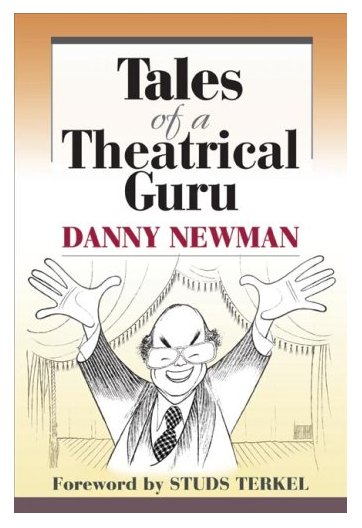 BD: Are we getting
more to the point where the general public — even
the non-participatory public — is becoming proud
of the performing arts?
BD: Are we getting
more to the point where the general public — even
the non-participatory public — is becoming proud
of the performing arts?[From Broadway World, June 27, 2013 (text only, photo from another source)] Susan Mathieson Mayer, director of Lyric's marketing and communications department for the past twenty-five years, has chosen to leave her current position at the end of 2013, Lyric's general director Anthony Freud announced yesterday. Mathieson Mayer will work as an independent marketing and communications consultant for a variety of organizations. She will retain an association with Lyric, consulting on media-related and marketing projects. 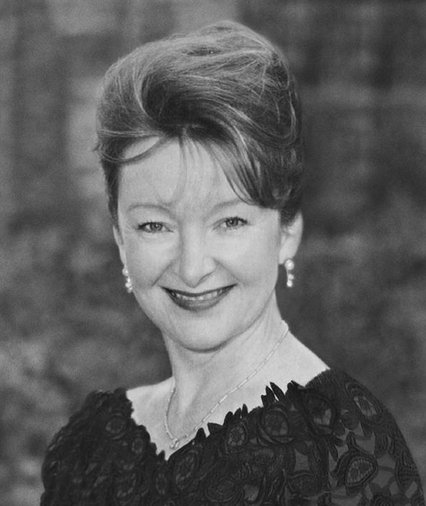 "It
is an honor to work for this great company," Mathieson Mayer said.
"However, I now want flexibility in my professional career so that I
can spend more time with my husband, Friedrich Mayer, who is retired." "It
is an honor to work for this great company," Mathieson Mayer said.
"However, I now want flexibility in my professional career so that I
can spend more time with my husband, Friedrich Mayer, who is retired."Freud said that the appointment process to recruit Mathieson Mayer's successor is well underway with an announcement expected within the next several weeks. "Susan has earned an international reputation for arts marketing and is widely acknowledged as one of the leading practitioners in the field today," Freud said. "She has made a major contribution to the company during her tenure, and will be greatly missed by her colleagues, Lyric's Board of Directors, and the artists. Just as Susan had big shoes to fill when she succeeded the legendary Danny Newman, so too will Susan's successor." Mathieson Mayer joined Lyric in 1988 and has the distinction of completely selling out the season for sixteen consecutive seasons (1989/90 through 2004/2005) - a record unequaled in the performing arts field. With its 25,000 season ticket holders, Lyric remains a leader in subscription sales and audience development. Because of Lyric's expanded programming and effective marketing, Lyric just announced a 15% increase in attendance for its 2012/13 season over the previous season. Mathieson Mayer has spearheaded a wide variety of audience-building initiatives for Lyric, as well as numerous high-profile branding projects for the company, including the 2011 advertising campaign "Long Live Passion," which featured Lyric's creative consultant and superstar soprano Renée Fleming; the naming of the Lyric Opera Bridge; and a series of Lyric Operathon fundraising posters that featured celebrities ranging from Michael Jordan to Bono. In 2000, Mathieson Mayer was named one of the country's Top 100 Marketers by Advertising Age- the only professional in the arts to be nominated. Prior to joining Lyric, Mathieson Mayer headed her own arts marketing firm. She was also director of marketing for the arts festival of the 1986 World's Fair in Vancouver, where she sold out 102 of the 106 events. While at the Vancouver Symphony in the 1980s, she built the subscription base to 42,000 - at the time, the largest orchestra subscription audience in the world. |
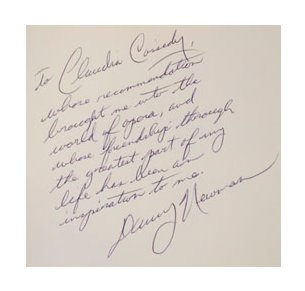 DN: Yes, within the
framework as I described. You must understand that if I have two
experimental plays or operas or ballets in a season of eight events,
which is 25%, the majority of people who attend tolerate the minority
of new items, or better still even comes over a little their
side. Then we can go on. That is generally accepted and
understood, though some people don’t like that system. They would
like to have all eight completely conventional and traditional.
DN: Yes, within the
framework as I described. You must understand that if I have two
experimental plays or operas or ballets in a season of eight events,
which is 25%, the majority of people who attend tolerate the minority
of new items, or better still even comes over a little their
side. Then we can go on. That is generally accepted and
understood, though some people don’t like that system. They would
like to have all eight completely conventional and traditional.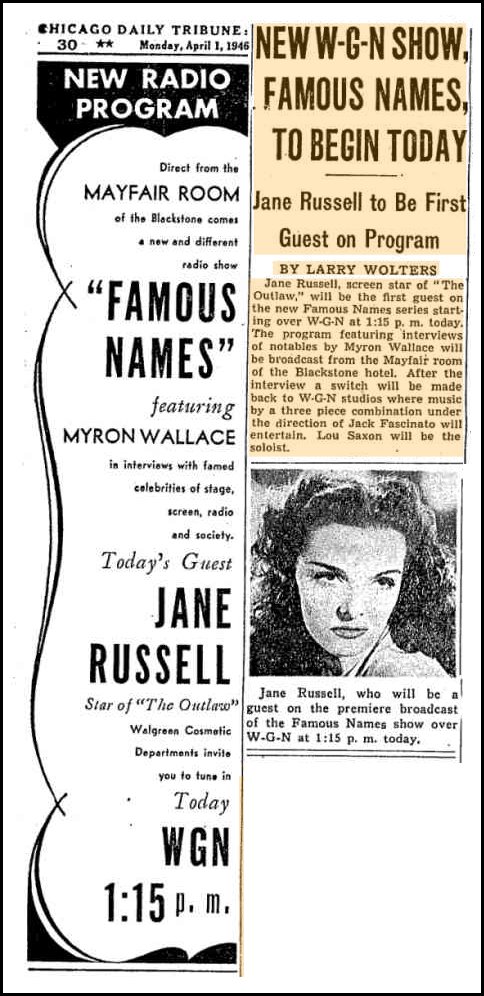 BD: I get the
feeling that you wouldn’t be happy unless you’re juggling several balls
at once!
BD: I get the
feeling that you wouldn’t be happy unless you’re juggling several balls
at once! DN: I must say I
have great satisfaction in that, and you’d be amazed to the extent I
keep track of them. I still know the figures because it’s very
important to me having affected the lives and careers of so many people
and so many institutions. In these years of activities, we have
built a vast network of organizations all over North America, not to
mention the projects overseas. We have given career fulfillment
and livelihood to thousands of artists of every kind. This is no
small thing. We’ve given prestige, respect, dignity, and a place
in the communities involved of those arts organizations that were never
occupied before. I’ve tried to remove the arts organizations from
being cheap, speculative, show business, hoping to find some rich man
who will pull them out somehow and get the curtain open. I want
them to be — and have succeeded in so many cases
— so patently successful that people come to them, wanting
to extend their help, wanting to jump onto their fast-moving bandwagons
and become part of it. I love that, and I must say that for me
this is a very, very great satisfaction. I dreamed it at one
time, and I have lived to see it happen. Everybody is fructified,
so to speak, by this kind of success. The artists thrive, the art
thrives, and the community is better because of it.
DN: I must say I
have great satisfaction in that, and you’d be amazed to the extent I
keep track of them. I still know the figures because it’s very
important to me having affected the lives and careers of so many people
and so many institutions. In these years of activities, we have
built a vast network of organizations all over North America, not to
mention the projects overseas. We have given career fulfillment
and livelihood to thousands of artists of every kind. This is no
small thing. We’ve given prestige, respect, dignity, and a place
in the communities involved of those arts organizations that were never
occupied before. I’ve tried to remove the arts organizations from
being cheap, speculative, show business, hoping to find some rich man
who will pull them out somehow and get the curtain open. I want
them to be — and have succeeded in so many cases
— so patently successful that people come to them, wanting
to extend their help, wanting to jump onto their fast-moving bandwagons
and become part of it. I love that, and I must say that for me
this is a very, very great satisfaction. I dreamed it at one
time, and I have lived to see it happen. Everybody is fructified,
so to speak, by this kind of success. The artists thrive, the art
thrives, and the community is better because of it.|
Maria Callas at Lyric Opera of Chicago
Two Performances of each opera, all conducted by Rescigno 1954 Norma [Opening Night] with Simionato, Picchi, Rossi-Lemeni Traviata with Simoneau, Gobbi Lucia di Lammermoor with Di Stefano, Guelfi, Stewart 1955 Puritani [Opening Night] with Di Stefano, Bastianini, Rossi-Lemeni, Wildermann Trovatore with Bjoerling, Stignani, Bastianini, Wildermann Madama Butterfly with Di Stefano, Weede, Alberts [Third performance added, which sold out in 98 minutes!] |
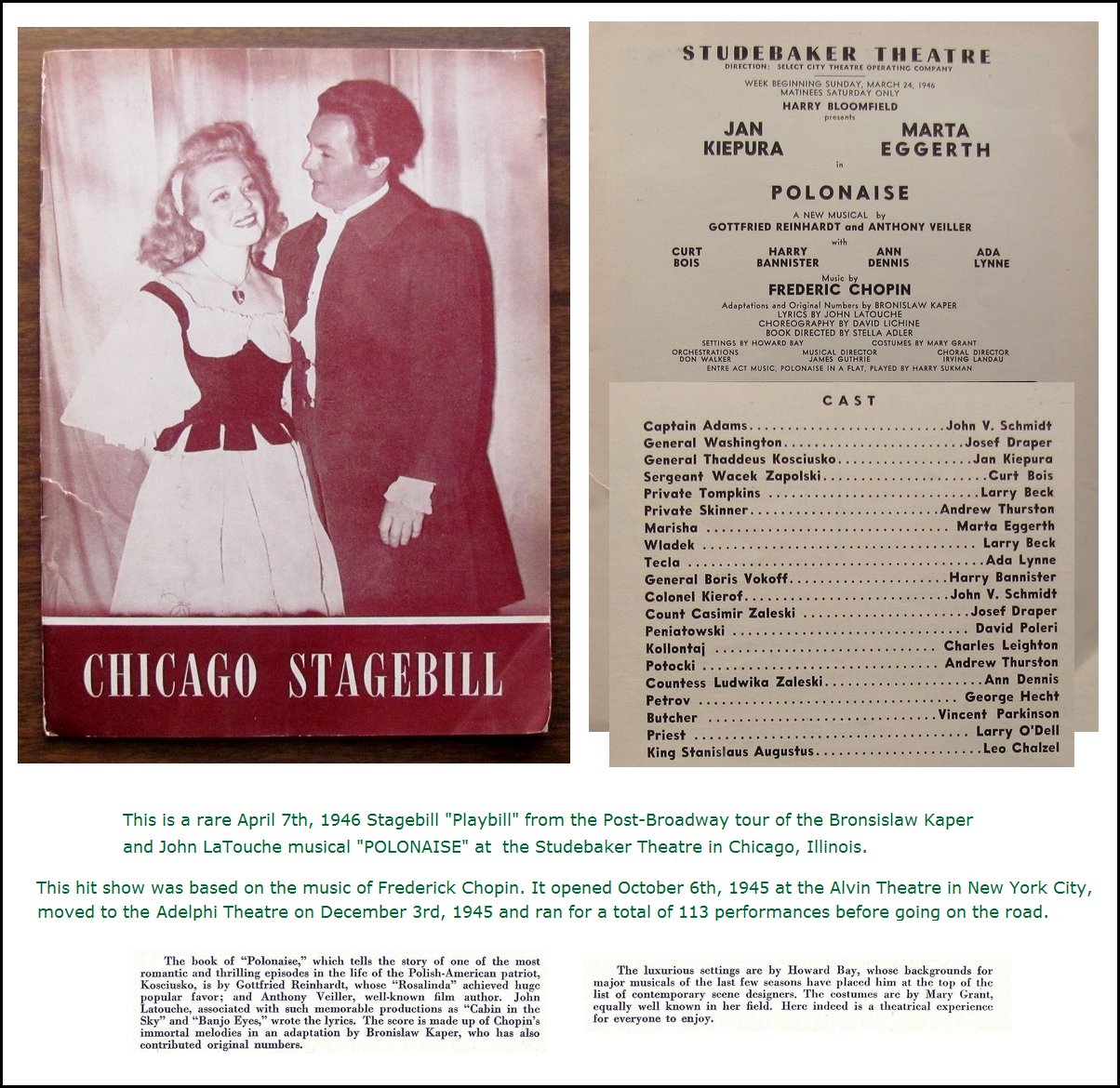
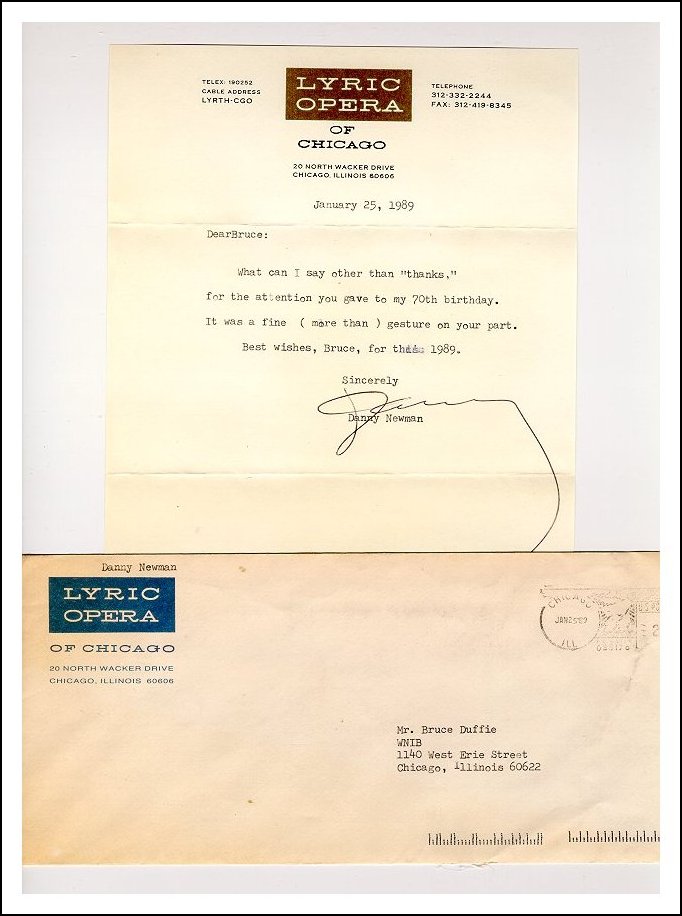 BD: So your
experience with those companies, and that company in particular, made
the success of Lyric Opera possible?
BD: So your
experience with those companies, and that company in particular, made
the success of Lyric Opera possible?This conversation was recorded in Chicago on January 18, 1999. It was the second of two interviews I had done with Newman; the previous one had been held on November 26, 1984. Portions of the first one were broadcast on WNIB in 1989 and 1994. A brief portion of this second interview was included on the Lyric Opera website during their 50th Anniversary Season in tribute to him as a Jubilarian. This transcription was made in 2015, and posted on this website at that time. My thanks to British soprano Una Barry for her help in preparing this website presentation.
To see a full list (with links) of interviews which have been transcribed and posted on this website, click here.
Award - winning broadcaster Bruce Duffie was with WNIB, Classical 97 in Chicago from 1975 until its final moment as a classical station in February of 2001. His interviews have also appeared in various magazines and journals since 1980, and he now continues his broadcast series on WNUR-FM, as well as on Contemporary Classical Internet Radio.
You are invited to visit his website for more information about his work, including selected transcripts of other interviews, plus a full list of his guests. He would also like to call your attention to the photos and information about his grandfather, who was a pioneer in the automotive field more than a century ago. You may also send him E-Mail with comments, questions and suggestions.